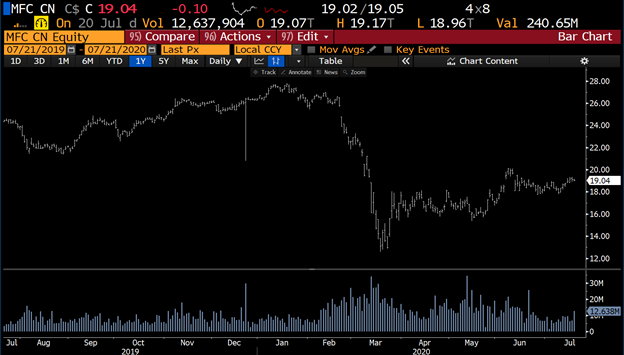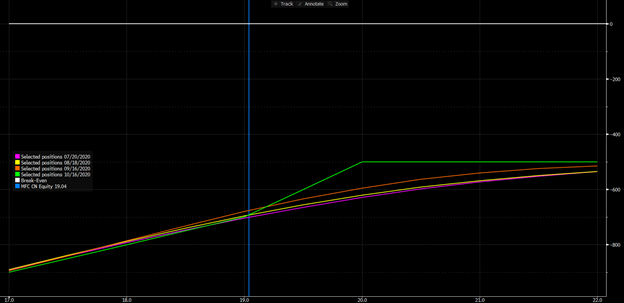Stock Repair Strategy Using Options

The coronavirus crisis seemed to come out of nowhere. It caught retail and professional investors off guard equally. Almost overnight many stocks fell by more than 25%, and although some have managed to recoup their losses over the past few months, many have not.
What is an investor to do in such an environment? One could simply hold on to a stock and hope that it recaptures the lost value. There is nothing wrong with this strategy since, over the long run, stocks generally do rise.
An alternative is to add to the position, lowering the cost base and making it such that the stock does not need to rally all the way back to the original price for the position to break even. The problem with this strategy is that it increases the risk, and if the investor is wrong in timing the bottom, the consequences can be disastrous.
However, there is an interesting technique that can improve the cost base without exposing the investor to added risk: the stock repair strategy.
How does it work?
Consider the example of an investor who purchased Manulife Financial at $26.00 in late 2019. Unfortunately, the coronavirus crisis caused the price of Manulife to plummet from $27.78 in early February 2020 all the way down to $12.58 in March. The stock has since rallied, but unfortunately it is still trading at only $19.04, which is well below the investor’s $26.00 cost base.
Chart 1: Manulife Financial (MFC) 2019-2020

Source: Bloomberg
To execute the stock repair strategy, the investor purchases a 1:2 ratio call spread, buying one at-the-money call while simultaneously shorting two out-of-the-money calls.
Consider an example using the prices from July 20, 2020. In this case, for every 100 shares of MFC stock the investor buys one contract of the October 16, 2020 call with a strike of $19, for $1.00. At the same time, the investor shorts two contracts of the October 16, 2020 call with a strike of $20, for $0.50.
Here is the profit and loss for the position, charting various points in time:
Chart 2: MFC stock repair strategy, profit and loss over time

Source: Bloomberg
At expiration, if the stock is below $19.00 then there will be no difference in the profit and loss, since all the calls will expire worthless and the investor is in the same situation as if he or she had not traded any options.
If the stock is between $19.00 and $20.00, then the $19.00-strike call has intrinsic value and the $20.00-strike calls expire worthless. This results in pure profit for the investor, improving the cost base of his or her shares.
If the stock is above $20, then all the options have intrinsic value. Using an expiration of $20.75, we see that the $19.00-strike call option is worth $1.75 and the $20.00-strike call options are worth $0.75. The investor will be covered on one of the short calls with the $19.00 strike, but will be forced to buy back the second one to ensure that the original stock position is kept intact. The cost base of the position will be improved by $1.00, but the upside beyond $20.00 will be limited, as the second call will have resulted in a sale at $20.00.
The green line in the above graph represents the pay-off at expiration. The profit improvement is limited at $20, but from there once the options expire, the investor can engage in another stock repair strategy leg to try to improve the cost base again with a new strike and expiration.
The stock repair strategy is an interesting technique to help improve your cost base after a steep decline. This strategy can be much more attractive than adding to the position, because the stock repair strategy decreases risk instead of increasing it. Oftentimes this is exactly the sort of strategy that is needed after a large loss that has taken an emotional toll.
Disclaimer:
The strategies presented in this blog are for information and training purposes only, and should not be interpreted as recommendations to buy or sell any security. As always, you should ensure that you are comfortable with the proposed scenarios and ready to assume all the risks before implementing an option strategy.
Derivatives Market Specialist
Big Picture Trading Inc.
Patrick Ceresna is the founder and Chief Derivative Market Strategist at Big Picture Trading and the co-host of both the MacroVoices and the Market Huddle podcasts. Patrick is a Chartered Market Technician, Derivative Market Specialist and Canadian Investment Manager by designation. In addition to his role at Big Picture Trading, Patrick is an instructor on derivatives for the TMX Montreal Exchange, educating investors and investment professionals across Canada about the many valuable uses of options in their investment portfolios.. Patrick specializes in analyzing the global macro market conditions and translating them into actionable investment and trading opportunities. With his specialization in technical analysis, he bridges important macro themes to produce actionable trade ideas. With his expertise in options trading, he seeks to create asymmetric opportunities that leverage returns, while managing/defining risk and or generating consistent enhanced income. Patrick has designed and actively teaches Big Picture Trading's Technical, Options, Trading and Macro Masters Programs while providing the content for the members in regards to daily live market analytic webinars, alert services and model portfolios.
The information provided on this website, including financial and economic data, quotes and any analysis or interpretation thereof, is provided solely for information purposes and shall not be construed in any jurisdiction as providing any advice or recommendation with respect to the purchase or sale of any derivative instrument, underlying security or any other financial instrument or as providing legal, accounting, tax, financial or investment advice. Bourse de Montréal Inc. recommends that you consult your own advisors in accordance with your needs before making decision to take into account your particular investment objectives, financial situation and individual needs.
All references on this website to specifications, rules and obligations concerning a product are subject to the rules, policies and procedures of Bourse de Montréal Inc. and its clearinghouse, the Canadian Derivatives Clearing Corporation, which prevail over the content of this website. Although care has been taken in the preparation of the documents published on this website, Bourse de Montréal Inc. and/or its affiliates do not guarantee the accuracy or completeness of the information published on this website and reserve the right to amend or review, at any time and without prior notice, the content of these documents. Neither Bourse de Montréal Inc. nor any of its affiliates, directors, officers, employees or agents shall be liable for any damages, losses or costs incurred as a result of any errors or omissions on this website or of the use of or reliance upon any information appearing on this website.
BAX®, CADC®, CGB®, CGF®, CGZ®, LGB®, MX®, OBX®, OGB®, OIS-MX®, ONX®, SCF®, SXA®, SXB®, SXF®, SXH®, SXM®, SXO®, SXY®, and USX® are registered trademarks of the Bourse. OBW™, OBY™, OBZ™, SXK™, SXJ™, SXU™, SXV™, Montréal Exchange and the Montréal Exchange logo are trademarks of the Bourse. All other trademarks used are the property of their respective owners.
© 2024 Bourse de Montréal Inc. All Rights Reserved.
